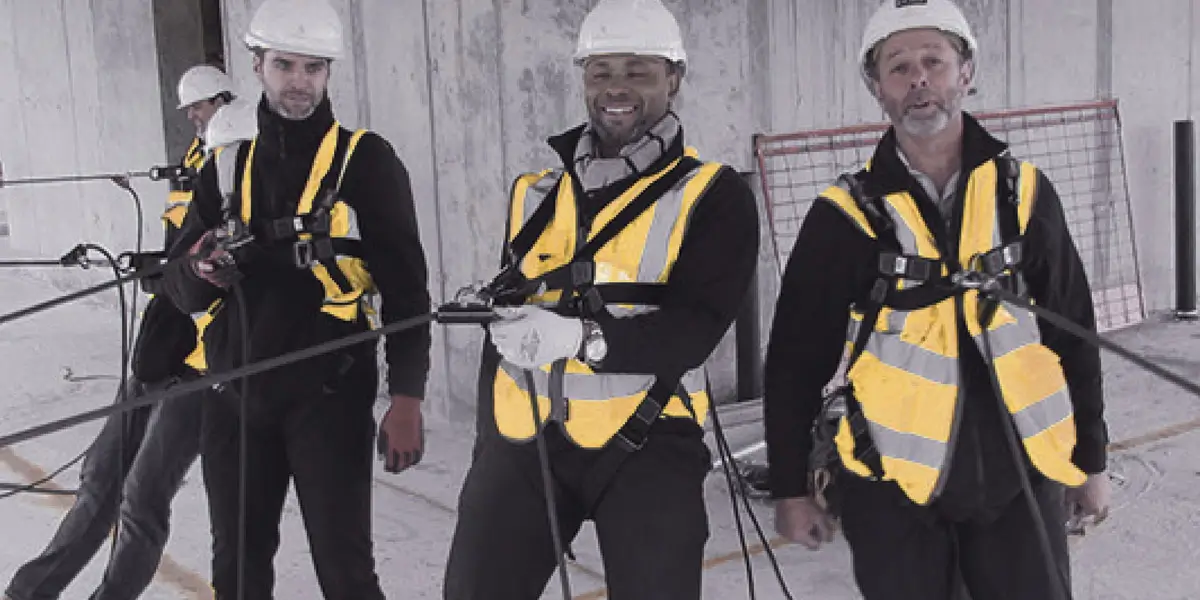
When you learn how to wear a height safety harness, you realise there’s a lot more to it than simply throwing it on and hoping for the best. Every type of full body harness has to be worn in the same way, whether it is standard polyester, non elasticised webbing, or elasticised safety harnesses. There are a number of points on the harness you need to be aware of – lets take a look:
On the rear of the safety harness is the Dorsal Plate, this could be rubber, plastic or form part of the harness webbing pattern. This piece is extremely important as it prevents the “D” ring from slamming into the back of your head in fall and converting the harness in a noose. The D-ring connects your harness to the anchorage point via intermediate attachments. Some harnesses have an adjustment for height via buckles on shoulder straps, the simplest rule for this type of harness is that you should not be able to touch the Dorsal Plate by reaching from behind your head, or by reaching up from the lumber or lower back region. Modern harness design has taken this feature out of the system to reduce miss-use of the harness. The full body type of harness may be elasticised to encourage correct fitting, and for the users comfort.
On the front of the safety harness should be a chest strap, some harnesses have a metal buckle, and possibly a D-ring on the front. This is to provide the user with a way of attaching to an anchor, or safe system of work, for example ladder systems. The important thing to note with this type of attachment is that unless the harness is worn correctly; there is a risk that the D-ring and buckle can strike the user in the neck and under the chin if you are involved in a fall. Some safety harness designs have replaced this D-ring with soft loops as a front connection, as this feature makes the harness safer for the user.
The chest strap, without a front attachment is much smaller and made of softer webbing, the chest strap is there to stop the shoulder straps from parting and allowing the user to fall out the front of their harness. However, in both cases it is important to take care when attaching your safety equipment in relation to the D-ring. If the anchorage point is behind you, then use the rear “D” ring and vice versa if the anchor point is in front of you.
Once you have put the harness on, like a jacket, and adjusted the chest strap so it is tight but comfortable, we need address the leg straps, buckles and sliders, there is more to it than just stepping into harness.
Stepping into a commercial full body safety harness is considered to be extremely bad practice! Not only does it increase the risk of slips trips and falls; if the harness is placed on the ground it could pick up all kinds of dirt and contamination. There is also a risk of complacency setting in; where the user steps into the harness in a rush, and fails to adjust it appropriately. In a fall a slack harness can lead to death or worse, extreme testicular trauma and/or severe rectal damage. Now that’s a world of real pain, and you don’t want that to happen. The easiest way to gauge the correct tension of the leg straps is to tighten it until you can just about get 2 fingers between the webbing and your leg. Two finger tension means placing the middle and index finger perpendicular to the webbing around the front area of the leg.
The final thing, and probably the most important thing, is to lock your harness! Every harness with a buckle used for adjustment should have at least one slider to lock it. That’s the plastic or rubber loop that slides up and down the webbing. If the harness is not locked and you are involved in a fall, the movement of the webbing through the buckle can cause the bar tack to shock-load against it. The bar tack is rolled over and lightly stitched – it is only there to keep the sliders and buckles on the harness. If the energy from a fall exceeds the strength of this stitching, it will rip apart and you will fall through the bottom of the harness!
It doesn’t matter if you are wearing the safety harness correctly, if it’s damaged it’s useless, and will offer you no protection whatsoever. Harnesses need to be inspected on a regular basis to establish they are safe to use.
See our blog post – How Often Should Working at Height Equipment be Inspected
Copyright 2025 Leading Edge Safety. Devloped by Czargroup Technologies